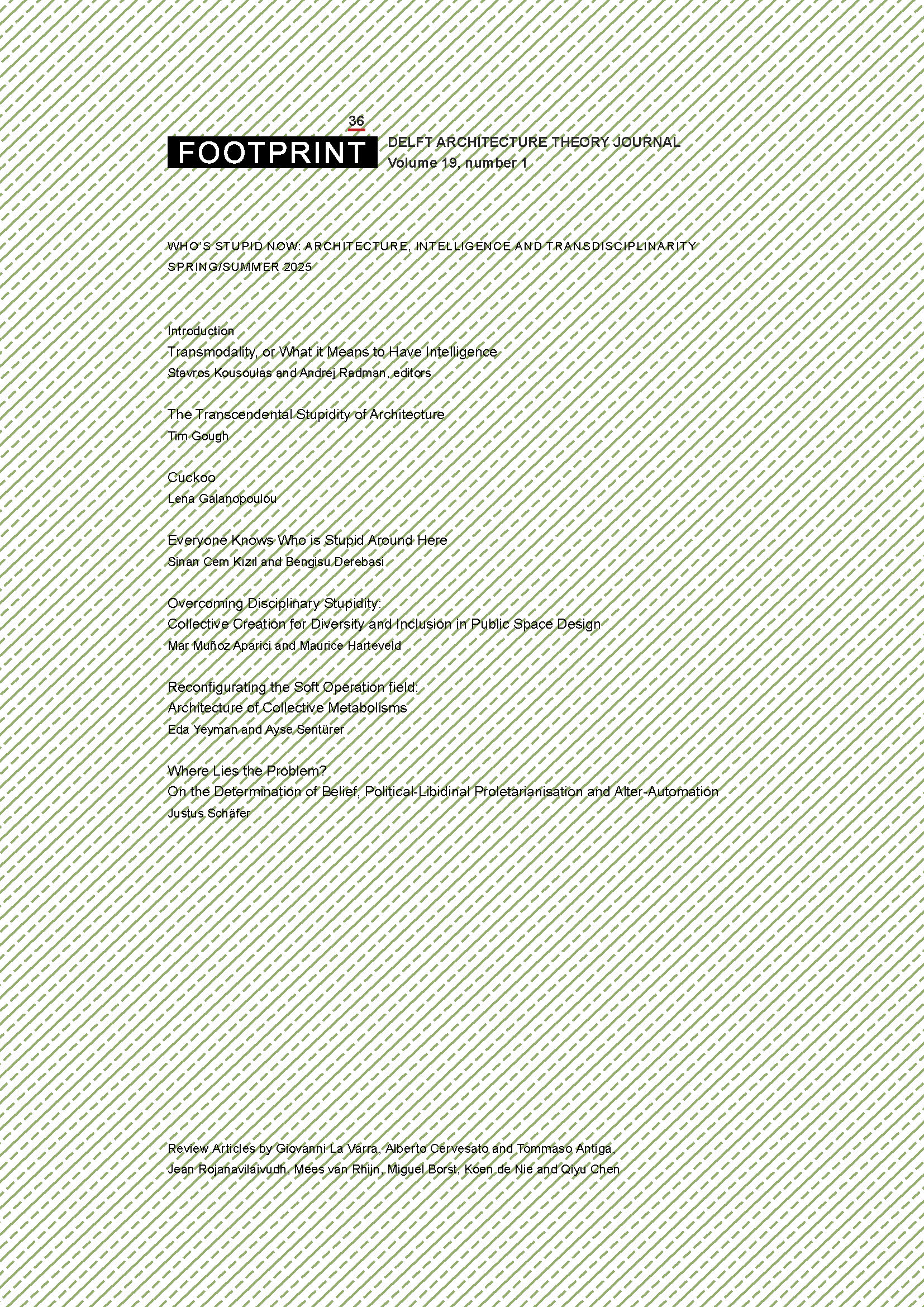Critique of Forest Intelligence
Scenarios for Architecture and the City in the Twenty-First Century (and Beyond)
DOI:
https://doi.org/10.59490/footprint.19.1.7725Abstract
This contribution starts from a question: in what terms can the design reason that is guiding the action of numerous contemporary architects, city planners and project makers be considered and defined? We argue that that such reason can be defined as ‘forest intelligence’, opposed to the human-animal intelligence that has instead characterised the repertoire of architectural-urban solutions from modernity onwards. The latter is characterised by verticality, exemplified by classes of opposites such as centre and periphery, the space of ‘nature’ and the space of the ‘city’. On the other hand, the new ‘forest intelligence’ is characterised by horizontality – urban polycentrism, interrelation between the parts of the city, absence of a clear division between ‘natural’ and urban space. Therefore, we have investigated three remarkable moments of the first quarter of our century. From the art world, the Documenta 13 exhibition (2012); representing architecture and landscape design, Gilles Clément’s Manifeste du Tiers paysage (2004); and from the field of politics, the ‘New Landscape Declaration’ (2016), an updated manifesto for landscape practice. We believe that these three specific and topical events can be understood as activators, initiators and at the same time as spaces for publicising the aforementioned ‘forest intelligence’.
References
Agamben, Giorgio. ‘Su ciò che possiamo non fare’. In Nudità, by Giorgio Agamben, 67-70. Milan: Nottetempo, 2009.
Agnoletto, Matteo. ‘Artful confusion’. Parametro, no. 264-265 (2006): 24–27.
Barad, Karen. Meeting the Universe Halfway. Quantum Physics and the Entanglement of Matter and Meaning. Durham: Duke University Press, 2007.
Boeri, Stefano. Urbania. Rome: Laterza, 2021.
Butler, Judith. La forza della nonviolenza. Un vincolo etico-politico. Milan: Nottetempo, 2020.
———. Perdita e rigenerazione. Ambiente, arte, politica. Venice: Marsilio, 2023.
Caffo, Leonardo. ‘Che cosa fa l’arte oggi? Dalla transavanguardia all’Arte come Anticipazione di Fragilità nell’età della velocità di fuga’. Flash Art (online), 14 October 2021. https://flash---art.it/2021/10/abo-castello-di-rivoli-leonardo-caffo/.
———. Fragile umanità. Il postumano contemporaneo. Turin: Einaudi, 2017.
———. ‘Il primo squarcio nelle Geografie Cartesiane’. BLOOM 26 (2015): 21-36.
———. ‘Il verde nel grigio. Una teoria dell’innesto’. viaBorgogna3. Il Magazine della Casa della Cultura, no. 3 (2016): 46-49.
———. Velocità di fuga. Sei parole per il contemporaneo. Turin: Einaudi, 2022.
Calder, Barnabas. Architecture. From Prehistory to Climate Emergency. London: Penguin, 2021.
Carta, Maurizio. Homo urbanus. Città e comunità in evoluzione. Rome: Donzelli, 2022.
Clément, Gilles. Breve trattato sull’arte involontaria. Testi, disegni e fotografie. Macerata: Quodlibet, 2022.
———. Manifeste du Tiers paysage. Paris: Sujet/Objet, 2004.
———. Manifesto del Terzo paesaggio. Macerata: Quodlibet, 2016.
Coccia, Emanuele. ‘La fine della lotta delle specie’. In Comp(h)ost. Immaginari interspecie, edited by Francesca Comisso, Luisa Perlo, and Marianna Vecellio, 92-97. Rome: Nero, 2021.
———. ‘La natura comune. Oltre la città e la foresta’. Vesper. Rivista di architettura, arti e teoria, no. 3 (2020): 96-107.
———. ‘Reversing the New Global Monasticism’. Log, no. 49 (2020): 9-17.
Council of Europe. European Landscape Convention (Florence Convention) (2000). https://www.premiopaesaggio.beniculturali.it/wp-content/uploads/2021/04/convenzioneeuropea.pdf.
DDHU – Universal Declaration of Humankind Rights (2015). https://ddhu.org.
Descola, Philippe. Par-delà nature et culture. Paris: Gallimard, 2005.
European Commission. Nature Restoration Law (2024). https://environment.ec.europa.eu/topics/nature-and-biodiversity/nature-restoration-law_en?prefLang=it#documents.
———. The European Green Deal (2019). https://eur-lex.europa.eu/legal-content/EN/TXT/PDF/?uri=CELEX:52019DC0640.
Ferran, Florence, Claudia Mattogno, and Annalisa Metta, eds. Coltiviamo il nostro giardino. Osare nuovi paesaggi, prendersi cura, inselvatichire il mondo. Rome: DeriveApprodi, 2019.
Filippi, Massimo, and Marco Reggio, eds. Corpi che non contano. Judith Butler e gli animali. Milan-Udine: Mimesis, 2015.
Gandy, Matthew, ed. Natura Urbana. Ecological Constellations in Urban Space. Cambridge, USA: The MIT Press, 2022.
Graham, James, Caitlin Blanchfield, Alissa Anderson, Jordan Carver, and Jacob Moore, eds. Climates. Architecture and the Planetary Imaginary. Zurich: Lars Müller, 2016.
Haraway, Donna J. Staying with the Trouble. Making Kin in the Chthulucene. Durham: Duke University Press, 2016.
Haraway, Donna J. Manifesto cyborg. Donne, tecnologie e biopolitiche del corpo. Milan: Feltrinelli, 2020.
———. Manifesto delle specie compagne. Cani, persone e altri partner. Milan: Contrasto, 2023.
Haraway, Donna J., and Thyrza Nichols Goodeye. Come una foglia. Roma: Tlon, 2024.
Heidegger, Martin. Concetti fondamentali della metafisica. Mondo, finitezza, solitudine. Genova: Il Melangolo, 1992.
IPCC – Intergovernmental Panel On Climate Change, ed. ‘Urban Systems and Other Settlements’. In Climate Change 2022 - Mitigation of Climate Change, 861–952. Cambridge, UK: Cambridge University Press, 2023. https://doi.org/10.1017/9781009157926.010.
Kohn, Eduardo. How Forests Think. Toward an Anthropology Beyond the Human. Berkeley: University of California Press, 2013.
Konijnendijk, Cecil C. The Forest and the City. The Cultural Landscape of Urban Woodland. Berlin: Springer, 2008.
La Varra, Giovanni. ‘Bosco (analogo)’. In Le parole e le forme – Book of Papers. Decimo Forum ProArch, edited by Laura Arrighi, Elisabetta Canepa, Christiano Lepratti, Beatrice Moretti, and Davide Servente, 266–71. Roma: ProArch – Società Scientifica del Progetto di Architettura, 2023.
Landscape Architecture Foundation, ed. The New Landscape Declaration. A Call to Action for the Twenty-First Century. Los Angeles: Rare Bird Books, 2017. https://www.lafoundation.org/take-action/new-landscape-declaration.
Laugier, Marc-Antoine. Essai sur l’architecture, 1753.
Le Corbusier. Vers une architecture. Paris: Crès, 1923.
Marini, Sara, ed. Vesper n. 3 – Nella selva / Wildness. Macerata: Quodlibet, 2020.
Melville, Herman. Bartleby, the Scrivener. A Story of Wall Street, 1853.
Metta, Annalisa. Il paesaggio è un mostro. Città selvatiche e nature ibride. Rome: DeriveApprodi, 2022.
Metta, Annalisa, and Maria Livia Olivetti, eds. La città selvatica. Paesaggi urbani contemporanei. Melfi: Libria, 2019.
Milizia, Francesco. Principj di architettura civile, 1781.
Molinari, Luca. Le case che siamo. Milan: Nottetempo, 2020.
Morton, Timothy. Ecology Without Nature. Rethinking Environmental Aesthetics. Cambridge (UK): Harvard University Press, 2009.
Olivetti, Maria Livia. La foresta civile. Un breviario per i boschi urbani contemporanei. Melfi: Libria, 2024.
Pelluchon, Corine. L’età del vivente. Per un nuovo Illuminismo. Rome: Donzelli, 2023.
Pievani, Telmo, and Mauro Varotto. Viaggio nell’Italia dell’Antropocene. La geografia visionaria del nostro futuro. Sansepolcro: Aboca, 2021.
Scardi, Gabi. ‘dOCUMENTA (13)’. Domus online, 5 July 2012. https://www.domusweb.it/it/arte/2012/07/05/documenta-13-.html.
Schambelan, Elizabeth. ‘Talks with Curator Carolyn Christov-Bakargiev about dOCUMENTA (13)’. ArtForum (Online), June 2012. https://www.artforum.com/columns/talks-with-curator-carolyn-christov-bakargiev-about-documenta-13-199963/.
Secchi, Bernardo. La città del ventesimo secolo. Rome: Laterza, 2005.
Sposito, Cesare, and Francesca Scalisi. ‘Riflessioni e traiettorie di ricerca interdisciplinari sulla transizione energetica’. Agathón. International Journal of Architecture, Art and Design, no. 15 (2024): 3-17. https://doi.org/10.19229/2464-9309/1502024.
Stengers, Isabelle. Au temps des catastrophes. Résister à la barbarie qui vient. Paris: La Découverte, 2008.
Tafuri, Manfredo. Progetto e utopia. Architettura e sviluppo capitalistico. Rome-Bari: Laterza, 1973.
Turan, Neyran. Architecture as Measure. New York-Barcelona: Actar, 2020.
UN – United Nations. Our Common Future [Brundtland Report], 1987.
———. Tranforming Our World. The 2030 Agenda for Sustainable Development, A/RES/70/1 § (2015). https://undocs.org/en/A/RES/70/1.
Viveiros De Castro, Eduardo. ‘Cosmological Deixis and Amerindian Perspectivism’. The Journal of the Royal Anthropological Institute 4, no. 3 (1998): 469-488. https://doi.org/10.2307/3034157.
Žižek, Slavoj. The Sublime Object of Ideology. London-New York: Verso Books, 1989.
Downloads
Published
Issue
Section
License
Copyright (c) 2025 Giovanni La Varra, Alberto Cervesato, Tommaso Antiga

This work is licensed under a Creative Commons Attribution 4.0 International License.
- Authors retain copyright and grant the journal right of first publication with the work simultaneously licensed under a Creative Commons Attribution License that allows others to share the work with an acknowledgement of the work's authorship and initial publication in this journal.
- Authors are able to enter into separate, additional contractual arrangements for the non-exclusive distribution of the journal's published version of the work (e.g., post it to an institutional repository or publish it in a book), with an acknowledgement of its initial publication in this journal.





